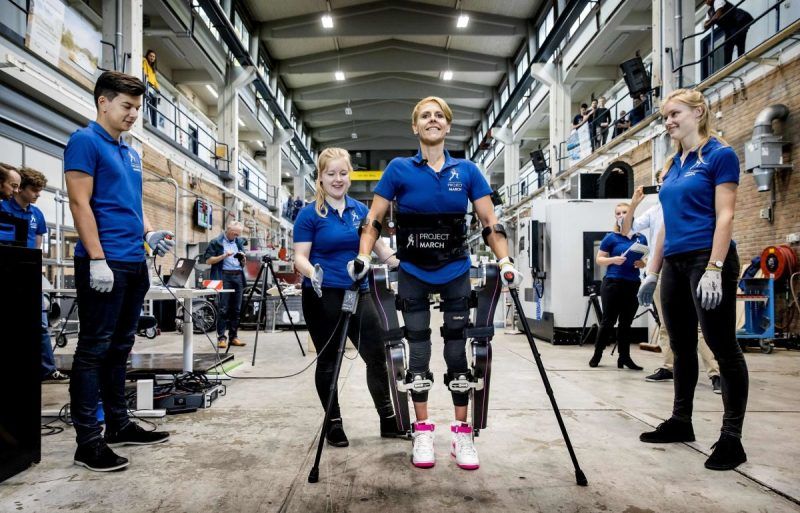
Performance enhancement and drugs in the sporting world have a bad rap. Nobody likes a cheater. But what if select sporting events encouraged the use of technological and scientific enhancements? What if some sports were based on human athleticism more akin to Formula One racing, where scientists, engineers and innovation play a significant role in who makes it to the winner’s podium?
Futurists and science fiction writers have long imagined Olympic-like games that emphasize radical technology and cyborg ability. An early rendition of this may look like the 2020 Cybathlon, held next May in Switzerland. Founded by the Swiss Federal Institute of Technology in Zurich and sometimes called the Cyborg Olympics, it will start before the 2020 Tokyo Olympics. Contestants — some of whom are missing limbs — compete in races involving everything from powered exoskeletons and brain-computer interfacing to motor-powered leg prostheses.
Traditional athletes often break world records by hundredths of a second, but the difference between the 2016 Cybathlon competitors and those in the upcoming games is likely to be stark: Technology has improved rapidly over the last four years. Computer chips, the foundation of some of the Cybathlon technology, are denser and more functional than they were in 2016. In the Brain-Computer Interface race, for example, brainwave-reading headsets are used to control avatars. The better the chip and its software, the easier the competitor can control his avatar. This same technology is what applies in the real world to quadriplegics that instruct motorized wheelchairs and other devices to move.
In the Functional Electronics Stimulation Bike Race, paraplegics use intelligent control devices to stimulate paralyzed muscles which have electrodes placed on them underneath the skin or directly on top of it. Despite their spinal cord injury which affects their legs, they are still able to control these muscles to pedal a recumbent bike around a circular track and engage in speed competition.
Cyborg games may spur the sporting industry and attract new viewers. Last year I saw the inventor Keahi Seymour run jaw-droppingly fast at about 25 miles per hour, wearing 18-inch high custom boots. Over 30 years, Mr. Seymour improved his bionic boots to allow him to run nearly the same speed as the Olympic sprint champion Usain Bolt.
It’s likely that with further improvements, bionic boots and exoskeleton suits will allow humans to run faster than ostriches, currently the fastest bipedal mammal. Humans running at vastly improved speeds could make the impossible possible — 500-mile ultraruns, hunting deer by hand, sprinting on water. No one has yet run on water, but Italian researchers in a 2012 study estimated that to do so a human, mimicking the basilisk lizard, would have to run 67 miles per hour.
Some exoskeleton technology is already controlled by the mind. Famously, a 29-year-old paraplegic man, fully paralyzed from the waist down, kicked a soccer ball to start the 2014 World Cup; he was using a mind-controlled exoskeleton suit. And in Florida mind-controlled headsets are used to race drones around a track.
When it’s allowed, people don’t find the use of technology in sports controversial. It’s drug use by athletes that causes the greatest contention. These days, any major competition is rife with strict blood and urine tests, creating a strong policing atmosphere in professional sports.
I wonder whether the sporting industry might create some new competitions where — just like technology — performance-enhancing drugs are encouraged. Innovations like the new oxygen-infused injection, which might one day allow humans to hold their breath for 15 to 30 minutes, could allow competitive free divers to reach new depths, showing just how far the human body can go.
Critics will complain that the human body was not designed to compete using enhancements and that doing so violates the code given to us by the ancient Greeks and their first Olympics Games, where arete, or excellence and moral virtue, was cherished. As a longtime competitive athlete, I appreciate the sportsmanship angle; but I also think that in the 21st century we can develop both the drugs and the technology to see humans compete in new sporting events that are even more exciting than their predecessors.
It’s hard to imagine the public wouldn’t want to see swimmers with fingers surgically webbed together to act like paddles, or weight lifters using short-lasting adrenaline shots, or 150-mile-per-hour baseball pitches thrown from bionic limbs.
Drugs and performance-enhancing technology would not have to challenge any existing sporting competitions and their cultures. It would simply be a new category of sports with different athletes. And like the Cybathlon, these types of competition would do more than just entertain — they would lead the way forward for the medical and transhumanist industries seeking to improve the human being. Competitions would be pilgrimages for medical professionals and entrepreneurs looking to buy and possibly mass produce the latest unique technologies.
Humans already use performance-enhancing drugs and technology in many everyday activities, including Viagra for sex, plastic surgery for appearing younger, and eye contacts for improving vision. We can extend that same open-mindedness to select sporting events and reveal what the human being can do athletically. If we encourage ourselves to improve our natural form — and use our collective imagination — we may find our species in an athletic renaissance.
Zoltan Istvan writes and lectures about transhumanism. His new book is The Futuresist Cure, and he is the subject of the documentary “Immortality or Bust.
